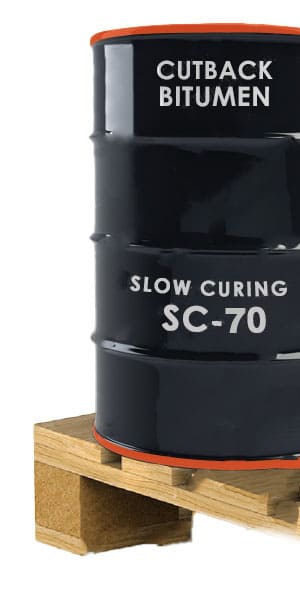Slow Curing (SC) Cutback Bitumen
Petroleum solvents fluidize asphalt in slow-curing (SC) cutback grades, like SC-70 to SC-3000, predominantly used for road mixing and dust suppression.
Overview
Understanding Slow-Curing Cutback Asphalt
Petroleum solvents are used to fluidize asphalt cement in asphalt cutbacks. These solvents are called distillates, diluents, or cutter stocks. If the solvent used in making the cutback asphalt is highly volatile, it will evaporate quickly, while solvents of lower volatility evaporate more slowly. Based on the relative speed of the solvent fraction’s evaporation, cutback asphalts are divided into three types: rapid-curing (RC), medium-curing (MC) and slow-curing (SC).
Asphalt cement diluents in the low volatility range are added to slow-curing (SC) cutback asphalt cement. SC-70, SC-250, SC-800, and SC-3000 are slow-curing cutback grades.
The fluidity developed by a cutback depends largely on the ratio of asphalt cement to solvent. Hardness of the base asphalt from which the cutback is made may affect the liquidity of the cutback to a lesser degree. There are several grades of cutback asphalt depending on the degree of fluidity, some quite fluid at ambient temperatures and others somewhat more viscous. It may be necessary to heat the viscous grades to make them fluid enough for construction operations.
SC cutback asphalts are often referred to as road oils and are used primarily for road mixing and dust suppression. The term originated in earlier days when asphalt residual oil was used to create all-weather roads at a low cost. Cutback asphalts are also used for stockpiling patches, are plant-mixed with graded aggregates, and are occasionally used for priming granular surfaces.
SC asphalt cement and low volatility oils generally in the heavy distillate range (SC-70, 250, 800, 3000). The degree of liquidity developed in each case is largely determined by the proportion of solvent to asphalt cement. The liquidity of the cutback may be affected to a minor degree by the hardness of the base asphalt. There are several grades of cutback asphalt depending on their degree of fluidity-some quite fluid at ordinary temperatures and others somewhat more viscous. For the more viscous grades, a small amount of heating may be necessary to make them fluid enough for construction.
Often referred to as road oils, slow-curing cutback asphalts are used primarily in road-mixing and dust laying. Asphalt residual oil was once used to make low-cost, all-weather surfaces for roads. SC cutback asphalts are also used for stockpile patching mixes, plant-mixed with graded aggregates and occasionally for priming.
Applications
Slow Curing Cutback Bitumen Applications
- Common applications include penetrating primer coats and producing patching or stockpile mixtures. When cutback asphalt is mixed with aggregates, it usually contains an adhesion agent to assist in coating the aggregate surface.
- Cutback agents are used to reduce the viscosity of bitumen when it is applied as a primer to a road pavement aggregate base course or substrate. At different concentrations, kerosene is used as a bitumen cutback agent.
- Due to the ease of use and no need to thin or heat, cutback bitumen is ideal for prime coats and cold application.
- Cutback bitumen SC involves incorporating asphalt into non-asphalt based courses prior to any subsequent treatment. Cutback asphalt SC is applied to waterproof surfaces, fill capillary voids, coat and bind loose mineral particles.
Uses of slow curing bitumen grades
- Current common uses are in penetrating prime coats and in producing patching or stockpile mixtures. Cutback asphalt used in mixing with aggregate will usually contain an adhesion agent to assist in the coating of the aggregate surface.
- consist of initial incorporation of asphalt into the surface of non-asphalt based course preparatory to any superimposed treatment of construction.
- Can apply to waterproofing of surfaces plug capillary voids, coat and bond loose mineral particles.
- The cutback bitumen is ideal for prime coat and cold applied because of easy uses and no need to thinning and heating.
- Cutback agents are used to lower the viscosity of bitumen when it is applied as a primer to the surface of a road pavement aggregate base course or substrate. Kerosene is used as a bitumen cutback agent at different concentrations according to local conditions and requirements.
Get in touch
Your Gateway to Top-Quality Bitumen
Elevate your projects with Gulf Bitumen’s superior quality and expertise. Contact us now to access top-notch bitumen solutions tailored to your needs.





